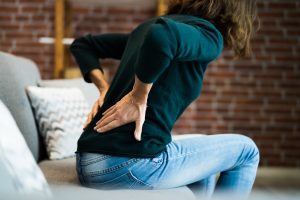Bone Spurs
Bone spurs, or osteophytes, are small, smooth projections that develop on the surface of a normal bone. Bone spurs can develop for a variety of reasons. One of the most common reasons is in response to friction – for instance, the friction that occurs within arthritic joints that have lost their smooth coating of cartilage. When joints develop arthritis, the exposed bones within the joint rub against each other and create friction. That’s when the body may build up extra bone in an attempt to strengthen the joint. The growths of bone are called bone spurs, although this term is not entirely accurate, since bone spurs are not sharp like a spur. As bone spurs grow larger, however, they can protrude into the nearby tissues, causing pain and other uncomfortable symptoms.
A bone spur can develop on virtually any bone in your body, including the vertebrae of the spine. When bone spurs develop on the bones in the spine, they can compress a nerve root or the spinal cord itself. This compression – and not the bone spur – is typically what causes pain and discomfort.
Causes of Bone Spurs
Bones conform to any pressure that is applied to them, and osteophytes are a common response to bone-to-bone pressure. Several different things can trigger these growths in the spine, such as:
- Disc Degeneration: Soft, cushioning discs separate the vertebrae of the spine. As these discs wear down, the vertebrae can come in contact with each other and trigger the development of bone spurs.
- Spinal Osteoarthritis: This condition occurs when the cartilage between the spine’s joints wears away. As exposed joint ends rub against each other, the result can be extra pressure and friction. In an attempt to stabilize the joints the body may create bone spurs.
- Traumatic Injury: This is a less common cause, but high-impact sports, auto accidents, and other sudden impacts can accelerate spinal deterioration and ultimately lead to the development of osteophytes.
- Natural Aging: With time, tendons (which hold muscles to bones) and ligaments (which hold the bones together) in the body can start to tighten and pull the bones away from where they should be. This can stimulate the production of osteophytes.
Smoking and carrying excess body weight aren’t direct causes of bone spurs, but they can accelerate spinal degradation, in turn increasing the likelihood of degenerative conditions like bone spurs. Other bone spur risk factors include a history of spinal traumas (including whiplash and compression fractures), a genetic predisposition to spinal degradation, and poor posture and eating habits.
Conservative treatment
Conservative therapies are often the first line of treatment for bone spurs. Your physician may recommend that you use a combination of these nonsurgical options for a period of several weeks or months while your progress is monitored.
Nonsurgical treatments options for osteophytes in the spine include:
- Pain medications, both prescription and over-the-counter
- Anti-inflammatory medications
- Corticosteroid injections
- Physical therapy
- Stretching and exercise
- Alternative therapies, such as acupuncture and chiropractic care
You may need to use a process of trial and error to determine which of these treatments are most beneficial for your specific needs. Sometimes, however, symptoms will persist until the bone spur and/or surrounding tissue is removed surgically to relieve pressure on a nerve. If this is the case, you will have a number of surgical options that you can consider.
Symptoms
In many cases, bone spurs are asymptomatic. You can have a bone spur without ever noticing anything out of the ordinary. However, if a bone spur pinches the spinal cord or the nerve roots that extend out of it, you may experience a number of uncomfortable symptoms.
In general, bone spurs that form along the spinal column and compress a nerve may cause severe localized pain, restricted movement, radiating arm and leg pain, weakness in the extremities, and numbness. However, your symptoms may vary depending on where in your spine the bone spur developed.
Common symptoms of spinal bone spurs include:
- If the bone presses on the nerve root in the cervical (upper) spine – It can cause pain and stiffness in the neck, headaches, and pain, numbness, tingling, or weakness that radiates out through the shoulders, arms, and hands.
- If a bone spur presses on the spinal cord in the neck – It can cause cervical myelopathy, a condition that can lead to muscle weakness in the legs and make it difficult to walk
- If the bone spur develops in the thoracic spine – It can cause discomfort in the center of the back behind the rib cage. Some symptoms may also travel to the abdomen, arms, and shoulders or to the lower extremities.
- If the bone spurs develop in the lumbar spine – It can cause pain and stiffness in the lower back, as well as pain, tingling, numbness, or weakness in the hips, buttocks, legs, and feet.
Diagnosis
If neck and back pain lasts more than a few days or a week, it is important to schedule a visit with a primary care physician. Your doctor can review your medical history and perform physical exams to understand the cause of any symptoms. If the suspected root of the pain, discomfort, or numbness is a bone spur, they will recommend other steps that can provide a much closer look at the affected area and make a specific diagnosis possible. Some of these options include:
- Radiographs/X-rays: Allow medical professionals to see the affected bones and compare the progress of the condition over time.
- CT Scans (in conjunction with radiographs): helps pinpoint the location of the bone spur by providing a cross-section view of the body.
- Electro-Conductive Tests: Such as EMG and nerve conduction tests, which can help eliminate other nerve compression sources from possible contributing factors.
Surgery
If you have been diagnosed with bone spurs or another degenerative spine condition, and conservative treatment is not providing you with relief from your symptoms, it might be time to consider other approaches, such as the minimally invasive spine surgery performed by BEST Health System. These include:
- Laminotomy – this procedure can create additional space in the spinal canal when a bone spur has developed and is crowding the canal.
- Foraminotomy – this procedure can be used to remove bone spurs and other tissues that are causing nerve compression inside a foramen.
- Facet Thermal Ablation – this procedure can be used to deaden a nerve ending inside an arthritic spinal facet joint.
For patients with more severe spinal degradation, we also offer a number of minimally invasive stabilization techniques, which are associated with the same benefits of our other minimally invasive procedures: potentially faster recovery times, lower average infection rates, and lower risk of complications compared to traditional open neck or back operations.
Get In Touch with The Experts at BEST Health System
If you have additional questions about your spinal bone spur or would like more information on the BEST Health System outpatient procedures, contact us today!
Related Articles
Can Sports Injuries Cause Spinal Bone Spurs?
Can Sports Injuries Cause Spinal Bone Spurs? Frequent participation in sports is one of the most common contributing spinal bone spur causes. While it is […]
Follow-Up Treatment for Bone Spurs
Understanding Bone Spurs Treatment for spinal bone spurs (osteophytes) usually focuses on pain management. In general, osteophytes only cause problems if they create pressure on […]
When to Consider Surgery for Osteophytes
What are Osteophytes? Osteophytes, also called bone spurs, can form near the joints or vertebrae of the spine. These small growths, while not necessarily painful, […]
Causes of Neck and Back Bone Spurs
What are Bone Spurs? Commonly found in the neck and back, bone spurs, also known as osteophytes, are excess bone growths that the body might […]
Bone Spurs - When Is Surgery Necessary?
Living with a Bone Spur Bone spurs, or osteophytes, are growths of bone that occur as a natural stabilizing response to friction, especially around the […]
How Do Bone Spurs Develop?
What is a Bone Spur? Your body may produce a bone spur to help fortify your spine if it becomes weakened by degeneration. A spinal […]
How To Know If I Have a Spinal Bone Spur
What is a Bone Spur? A bone spur is a small, smooth growth that can develop in the spine’s bones due to friction from years […]
3 Exercises to Help with Bone Spur Pain
What is a Bone Spur A bone spur is a bony growth that develops in the spine as a result of a traumatic injury or […]
How to Enhance the Effectiveness of Your Spinal Bone Spur Treatment
Bone Spurs In many cases, spinal bone spur treatment can be accomplished without surgery. Bone spurs, or osteophytes, are smooth bony deposits produced naturally by […]
Diagnosing a Spinal Bone Spur
What is a Bone Spur? A bone spur is a rounded, bony growth that generally forms on joints and often remains asymptomatic. In fact, many […]











